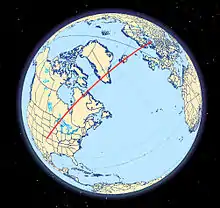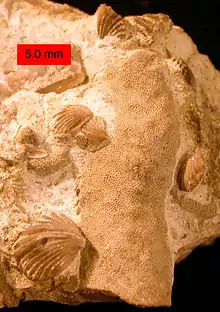Ordovician radiation
The Ordovician radiation, or the great Ordovician biodiversification event (GOBE), was an evolutionary radiation of animal life throughout[1] the Ordovician period, 40 million years after the Cambrian explosion,[2] whereby the distinctive Cambrian fauna fizzled out to be replaced with a Paleozoic fauna rich in suspension feeder and pelagic animals.[3]
It followed a series of Cambrian–Ordovician extinction events, and the resulting fauna went on to dominate the Palaeozoic relatively unchanged.[4] Marine diversity increased to levels typical of the Palaeozoic,[5] and morphological disparity was similar to today's.[6][7] The diversity increase was neither global nor instantaneous; it happened at different times in different places.[4] Consequently, there is unlikely to be a simple or straightforward explanation for the event; the interplay of many geological and ecological factors likely produced the diversification.[1]
Causes

Possible causes include changes in palaeogeography or tectonic activity, as well as a modified nutrient supply.[8] The dispersed positions of the continents, high level of tectonic/volcanic activity, warm climate, and high CO2 levels would have created a large, nutrient-rich ecospace, favoring diversification.[2] In addition, the changing geography led to a more diverse landscape, with more different and isolated environments; this no doubt facilitated the emergence of bioprovinciality, and speciation by isolation of populations.[1] On the other hand, global cooling has also been offered as a cause of the radiation,[9][10] and another alternative is that the breakup of an asteroid led to the Earth being consistently pummelled by meteorites,[3] although the proposed Ordovician meteor event happened at 467.5±0.28 million years ago.[11][12] Another effect of a collision between two asteroids, possibly beyond the orbit of Mars, is a reduction in sunlight reaching the Earth's surface due to the vast dust clouds created. Evidence for this event comes from the relative abundance of the isotope helium-3, found in ocean sediments laid down at the time of the biodiversification event. The most likely cause of the production of high levels of helium-3 is the bombardment of lithium by cosmic rays, something which could only have happened to material which travelled through space.[13] The volcanic activity that created the Flat Landing Brook Formation in New Brunswick, Canada may have caused rapid climatic cooling and biodiversification.[14]
The above triggers would have been amplified by ecological escalation, whereby any new species would co-evolve with others, creating new niches through niche partitioning, trophic layering, or by providing a new habitat.[8] As with the Cambrian Explosion, it is likely that environmental changes drove the diversification of plankton, which permitted an increase in diversity and abundance of plankton-feeding lifeforms, including suspension feeders on the sea floor, and nektonic organisms in the water column.[3] After the SPICE event about 500 million years ago, the extinction in the ocean would have opened up new niches for photosynthetic plankton, who would absorb CO2 from the atmosphere and release large amount of oxygen. More oxygen and a more diversified photosynthetic plankton as the bottom of the food chain, would have affected the diversity of higher marine organisms and their ecosystems.[15]
Effects

If the Cambrian Explosion is thought of as producing the modern phyla,[16] the GOBE can be considered as the "filling out" of these phyla with the modern (and many extinct) classes and lower-level taxa.[3] The GOBE is considered to be one of the most potent speciation events of the Phanerozoic era increasing global diversity severalfold.[17]
Notable taxonomic diversity explosions during this period include that of articulated brachiopods, gastropods and bivalves.[17]
Taxonomic diversity increased manifold; the total number of marine orders doubled, and families tripled.[4] In addition to a diversification, the event also marked an increase in the complexity of both organisms and food webs.[1] Taxa began to have localized ranges, with different faunas at different parts of the globe.[1] Communities in reefs and deeper water began to take on a character of their own, becoming more clearly distinct from other marine ecosystems.[1] And as ecosystems became more diverse, with more species being squeezed into the food web, a more complex tangle of ecological interactions resulted, promoting strategies such as ecological tiering.[1] The global fauna that emerged during the GOBE went on to be remarkably stable until the catastrophic end-Permian extinction and the ensuing Mesozoic Marine Revolution.[1]
The acritarch record (the majority of acritarchs were probably marine algae)[3] displays the Ordovician radiation beautifully; both diversity and disparity peaked in the middle Ordovician.[2] The warm waters and high sea level (which had been rising steadily since the early Cambrian) permitted large numbers of phytoplankton to prosper; the accompanying diversification of the phytoplankton may have caused an accompanying radiation of zooplankton and suspension feeders.[2]
The planktonic realm was invaded as never before, with several invertebrate lineages colonising the open waters and initiating new food chains at the end of the Cambrian into the early Ordovician.[18]
References
- Munnecke, A.; Calner, M.; Harper, D. A. T.; Servais, T. (2010). "Ordovician and Silurian sea-water chemistry, sea level, and climate: A synopsis". Palaeogeography, Palaeoclimatology, Palaeoecology. 296 (3–4): 389–413. Bibcode:2010PPP...296..389M. doi:10.1016/j.palaeo.2010.08.001.
- Servais, T.; Lehnert, O.; Li, J.; Mullins, G. L.; Munnecke, A.; Nützel, A.; Vecoli, M. (2008). "The Ordovician Biodiversification: revolution in the oceanic trophic chain". Lethaia. 41 (2): 99–109. doi:10.1111/j.1502-3931.2008.00115.x.
- Servais, T.; Owen, A. W.; Harper, D. A. T.; Kröger, B. R.; Munnecke, A. (2010). "The Great Ordovician Biodiversification Event (GOBE): the palaeoecological dimension". Palaeogeography, Palaeoclimatology, Palaeoecology. 294 (3–4): 99–119. doi:10.1016/j.palaeo.2010.05.031.
- Droser, M. L.; Finnegan, S. (2003). "The Ordovician Radiation: A Follow-up to the Cambrian Explosion?". Integrative and Comparative Biology. 43: 178–184. doi:10.1093/icb/43.1.178. PMID 21680422.
- Marshall, C. R. (2006). "Explaining the Cambrian "explosion" of Animals". Annual Review of Earth and Planetary Sciences. 34: 355–384. Bibcode:2006AREPS..34..355M. doi:10.1146/annurev.earth.33.031504.103001.
- Bush, A. M.; Bambach, R. K.; Daley, G. M. (2007). "Changes in theoretical ecospace utilization in marine fossil assemblages between the mid-Paleozoic and late Cenozoic". Paleobiology. 33: 76–97. doi:10.1666/06013.1.
- Bambach, R. K.; Bush, A. M.; Erwin, D. H. (2007). "Autecology and the Filling of Ecospace: Key Metazoan Radiations". Palaeontology. 50: 1–22. doi:10.1111/j.1475-4983.2006.00611.x.
- Botting, Muir; Muir, Lucy A. (2008). "Unravelling Causal Components of the Ordovician Radiation: the Builth Inlier (Central Wales) As a Case Study". Lethaia. 41: 111–125. doi:10.1111/j.1502-3931.2008.00118.x.
- Trotter, JA; Williams, IS; Barnes, CR; Lécuyer, C; Nicoll, RS (2008). "Did cooling oceans trigger Ordovician biodiversification? Evidence from conodont thermometry". Science. 321 (5888): 550–4. Bibcode:2008Sci...321..550T. doi:10.1126/science.1155814. PMID 18653889.
- Goldberg, Samuel L.; Present, Theodore M.; Finnegan, Seth; Bergmann, Kristin D. (2021-02-09). "A high-resolution record of early Paleozoic climate". Proceedings of the National Academy of Sciences. 118 (6). doi:10.1073/pnas.2013083118. ISSN 0027-8424.
- An extraterrestrial trigger for the mid-Ordovician ice age: Dust from the breakup of the L-chondrite parent body, Birger Schmitz et al, AAAS Science Advances, 18 Sep 2019: Vol. 5, no. 9, eaax4184; DOI: 10.1126/sciadv.aax4184, accessed 2019-10-09
- Lindskog, A.; Costa, M. M.; Rasmussen, C.M.Ø.; Connelly, J. N.; Eriksson, M. E. (2017-01-24). "Refined Ordovician timescale reveals no link between asteroid breakup and biodiversification". Nature Communications. 8: 14066. doi:10.1038/ncomms14066. ISSN 2041-1723. PMC 5286199. PMID 28117834.
It has been suggested that the Middle Ordovician meteorite bombardment played a crucial role in the Great Ordovician Biodiversification Event, but this study shows that the two phenomena were unrelated
- McKie, Robin (12 October 2019). "New evidence shows how asteroid dust cloud may have sparked new life on Earth 470m years ago". The Observer. ISSN 0029-7712. Retrieved 12 October 2019.
- "A mid-Darriwilian super volcano in northern New Brunswick, rapid climate change and the start of the great Ordovician biodiversification event" (PDF). Mineralogical Association of Canada. 2012. p. 119. Archived from the original (PDF) on 13 December 2019. Retrieved 2019-09-15.
- Solved: Mystery of Earth's First Breathable Atmosphere
- All mineralized phyla were present by the end of the Cambrian; see Landing, E.; English, A.; Keppie, J. D. (2010). "Cambrian origin of all skeletalized metazoan phyla--Discovery of Earth's oldest bryozoans (Upper Cambrian, southern Mexico)". Geology. 38 (6): 547–550. Bibcode:2010Geo....38..547L. doi:10.1130/G30870.1.
- Stigall, A.L; et al. (December 2016). "Biotic immigration events, speciation, and the accumulation of biodiversity in the fossil record". Global and Planetary Change. 148: 242–257. Bibcode:2017GPC...148..242S. doi:10.1016/j.gloplacha.2016.12.008.
- Kröger, B. R.; Servais, T.; Zhang, Y.; Kosnik, M. (2009). Kosnik, Matthew (ed.). "The Origin and Initial Rise of Pelagic Cephalopods in the Ordovician". PLoS ONE. 4 (9): e7262. Bibcode:2009PLoSO...4.7262K. doi:10.1371/journal.pone.0007262. PMC 2749442. PMID 19789709.